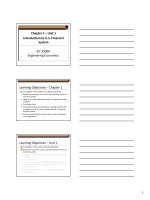Lecture Organizational behavior - Chap 1: Introducing organizational behavior
Bạn đang xem bản rút gọn của tài liệu. Xem và tải ngay bản đầy đủ của tài liệu tại đây (5.45 MB, 34 trang )
Chapter 1
Introducing Organizational
Behavior
People
Make the Difference
Copyright © 2014 John Wiley & Sons, Inc.
Chapter Learning
Objectives
What is organizational behavior and why is it
important?
How do we learn about organizational
behavior?
What is the context of organizational
behavior?
What are the challenges of management in
organizations?
What are the challenges of leadership in
organizations?Copyright © 2014 John Wiley & Sons, Inc.
1-2
What is organizational
behavior and why is it
Organizational behavior
important?
•
Study of human behavior in organizations.
• An interdisciplinary field devoted to
understanding individual and group behavior,
interpersonal processes, and organizational
dynamics.
Copyright © 2014 John Wiley & Sons, Inc.
1-3
What is organizational behavior
and why is it important?
Importance of Organizational Behavior
OB relevance test – fashion forward
titles like these:
Relationship champion, Logistic
ringmaster, Innovation game
changer, Collaboration pioneer,
Market trends virtuoso
Smart workforce – common
foundations with similar behaviors
drive job titles, such as networking,
connecting, collaborating, helping,
linking, supporting, seeking and
Copyright © 2014 John Wiley & Sons, Inc.
1-4
What is organizational
behavior and why is it
important?
Trends with human behavior in
organizations
Commitment to ethical behavior
Broader view of leadership
Emphasis on human capital and
teamwork
Demise of command-and-control
Importance of connections and
networks
Influence of information technology
Respect for new workforce
Copyright © 2014 John Wiley & Sons, Inc.
1-5
What is organizational
behavior and why is it
important?
What are the scientific foundations of
organizational behavior?
Interdisciplinary Body of Knowledge
Use of Scientific Methods
Models – simplified views of reality
that attempt to explain real-world
phenomena
Independent variables – presumed
causes that influence dependent
variables
Dependent variables – outcomes of
practical value and interest that are
Copyright © 2014 John Wiley & Sons, Inc.
1-6
Figure 1.1 Common Scientific Research
Methods in Organizational Behavior
Copyright © 2014 John Wiley & Sons, Inc.
1-7
What is organizational
behavior and why is it
Scientific thinking is important
to OB:
important?
• The process of data collection is controlled and
systematic.
• Proposed explanations are carefully tested.
• Only explanations that can be rigorously
verified are accepted.
Copyright © 2014 John Wiley & Sons, Inc.
1-8
What is organizational
behavior and why is it
Contingency thinking
important?
• Seeks ways to meet the needs of different
management situations.
• Recognizes responses to solutions must be
crafted to best fit the circumstances and people
involved.
Copyright © 2014 John Wiley & Sons, Inc.
1-9
What is organizational
behavior and why is it
Evidencedbased management
important?
• Uses hard facts and empirical evidence to make
decisions.
• Evidence-based thinking manifests itself
through a contingency approach which
researchers identify how different situations can
best be understood and handled.
Copyright © 2014 John Wiley & Sons, Inc.
1-
What is organizational
behavior and why is it
CrossCultural Awareness
important?
• Understanding from managers, employees to
government leaders and true understanding of
how OB theories and concepts apply in different
countries
Copyright © 2014 John Wiley & Sons, Inc.
1-
How do we learn about
organizational behavior?
Learning – an enduring change of behavior that results
from experience
Lifelong learning – involves learning continuously from
daytoday experiences
Copyright © 2014 John Wiley & Sons, Inc.
1-
Figure 1.2 Organizations as Open Systems
Interacting With Their Environments
Copyright © 2014 John Wiley & Sons, Inc.
1-13
How do we learn about
organizational behavior?
Get to Know Yourself Better
Take assessment 5, personal values, in the
OB skills workbook
What did you learn about your values?
Are they balanced?
Do the results suggest how you would
react in situations of ethics?
Copyright © 2014 John Wiley & Sons, Inc.
1-
How do we learn about
organizational behavior?
Organizations and the External
Environment
Organizations are collections of
people working together to achieve
a common purpose.
Open systems transform human
and material resource inputs into
finished goods and services.
Complex adaptive systems interact
and adapt with their environments
to survive.
Copyright © 2014 John Wiley & Sons, Inc.
1-
Figure 1.3 The Management Process of Planning,
Organizing, Leading, and Controlling
Copyright © 2014 John Wiley & Sons, Inc.
1-
How do we learn about
organizational behavior?
Stakeholders
• People, groups, and institutions that are
affected by and thus have an interest or
“stake” in an organization’s performance.
Copyright © 2014 John Wiley & Sons, Inc.
1-
How do we learn about
organizational behavior?
Internal Environment of Organizations
• Organizational culture is a shared
set of beliefs and values within an
organization.
• Organizational climate represents
shared perceptions of members
regarding what the organization is
like in terms of management
policies and practices.
Copyright © 2014 John Wiley & Sons, Inc.
1-
How do we learn about
organizational behavior?
Workforce diversity
• Presence of Individual differences based on
gender, race and ethnicity, age, ablebodiedness, and sexual orientation.
Copyright © 2014 John Wiley & Sons, Inc.
1-
How do we learn about
organizational behavior?
Multiculturalism refers to pluralism and respect for
diversity in the workplace.
Inclusion the degree to which an organization's culture
respects and values diversity.
Copyright © 2014 John Wiley & Sons, Inc.
1-
What is the context of
organizational behavior?
Manager someone whose job it is to directly support the
work efforts of others.
Effective manager helps others achieve high levels of both
performance and satisfactions.
Copyright © 2014 John Wiley & Sons, Inc.
1-
What is the context of
organizational behavior?
Task performance quality and quantity of the work
produced or the services provided by an individual, team,
or work unit, or organization as a whole.
Job satisfaction indicates how people feel about their work
and the work setting.
Copyright © 2014 John Wiley & Sons, Inc.
1-
What are the challenges
of management in
The management process.
organizations?
• Planning
• Organizing
• Leading
• Controlling
Copyright © 2014 John Wiley & Sons, Inc.
1-
Figure 1.4 The management process
Copyright © 2014 John Wiley & Sons, Inc.
1-24
Figure 1.5 Mintzberg’s 10
roles of effective
managers
Copyright © 2010 John Wiley &
1-









